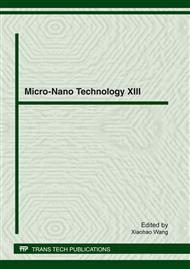[1]
Craciun, G., et al., Single Step Cryogenic SF6/O2 Plasma Etching Process for the Development of Inertial Devices. (2007).
Google Scholar
[2]
Abdolvand, R. and F. Ayazi, An advanced reactive ion etching process for very high aspect-ratio sub-micron wide trenches in silicon. Sensors and Actuators A: Physical, 2008. 144(1): pp.109-116.
DOI: 10.1016/j.sna.2007.12.026
Google Scholar
[3]
Puech, M., et al. A novel plasma release process and super high aspect ratio process using ICP etching for MEMS. 2003: Citeseer.
Google Scholar
[4]
Bogue, R., Developments in advanced silicon etching techniques by STS Systems. Sensor Review, 2002. 22(1): pp.41-45.
DOI: 10.1108/02602280210416132
Google Scholar
[5]
Fu, Y., et al., Aluminium Nitride thin Film Acoustic Wave Device for Microfluidic and Biosensing Applications.
Google Scholar
[6]
Huang, G., et al. Study of structural fabrication process of Film Bulk Acoustic Resonator (FBAR): IEEE.
Google Scholar
[7]
Yeom, J., et al., Maximum achievable aspect ratio in deep reactive ion etching of silicon due to aspect ratio dependent transport and the microloading effect. Journal of Vacuum Science & Technology B: Microelectronics and Nanometer Structures, 2005. 23: p.2319.
DOI: 10.1116/1.2101678
Google Scholar
[8]
Ayon, A.A., X. Zhang, and R. Khanna, Anisotropic silicon trenches 300-500 [mu] m deep employing time multiplexed deep etching (TMDE). Sensors and Actuators A: Physical, 2001. 91(3): pp.381-385.
DOI: 10.1016/s0924-4247(01)00611-2
Google Scholar
[9]
Marty, F., et al., Advanced etching of silicon based on deep reactive ion etching for silicon high aspect ratio microstructures and three-dimensional micro-and nanostructures. Microelectronics Journal, 2005. 36(7): pp.673-677.
DOI: 10.1016/j.mejo.2005.04.039
Google Scholar
[10]
Volland, B., et al., The application of secondary effects in high aspect ratio dry etching for the fabrication of MEMS. Microelectronic Engineering, 2001. 57: pp.641-650.
DOI: 10.1016/s0167-9317(01)00496-8
Google Scholar
[11]
Kovacs, G.T.A., N.I. Maluf, and K.E. Petersen, Bulk micromachining of silicon. Proceedings of the IEEE, 1998. 86(8): pp.1536-1551.
DOI: 10.1109/5.704259
Google Scholar
[12]
Bhardwaj, J., H. Ashraf, and A. McQuarrie. Dry silicon etching for MEMS.
Google Scholar
[13]
S kmen, et al., Shallow and deep dry etching of silicon using ICP cryogenic reactive ion etching process. Microsystem Technologies, 2010. 16(5): pp.863-870.
DOI: 10.1007/s00542-010-1035-7
Google Scholar


